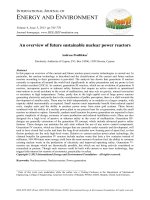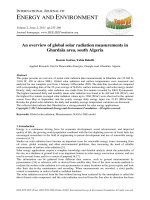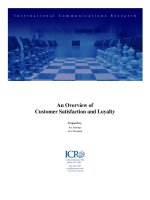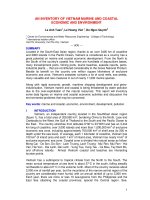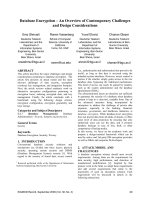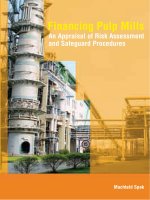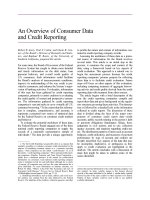An overview of petroleum potential and investment opportunities in Southeast Asia
Bạn đang xem bản rút gọn của tài liệu. Xem và tải ngay bản đầy đủ của tài liệu tại đây (1.83 MB, 6 trang )
Geosciences | Geology
An overview of petroleum potential and
investment opportunities in Southeast Asia
Minh Hoang Cu1*, Khac Hoan Phung1, Hai An Le2
1
PVEP Overseas Co., Ltd
Hanoi University of Mining and Geology
2
Received 2 June 2017; accepted 1 September 2017
Abstract:
Southeast Asia has 11 countries: Brunei, Cambodia, East Timor, Indonesia, Laos, Malaysia, Myanmar, Philippines,
Singapore, Thailand, and Vietnam. Southeast Asia is considered one of the most active economic development regions
in the world, with high demand for energy development, cultural diversity, and language. These countries and
Vietnam have good relationships in diplomacy and cooperation and in other fields; therefore, it is very convenient for
Vietnam to invest in oil and gas exploration and exploitation in the region. On the basis of evaluating the criteria of
natural conditions, geological features, sedimentary basins, exploration and exploitation status as well as investment
environment of each country in Southeast Asia, this article will introduce the most comprehensive information about
the potential and the overall picture of the oil and gas industry in Southeast Asia and in individual countries, thereby
providing information and orientation for investment opportunities of each country in the region.
Keywords: hydrocacbon reserves, investment opportunities, petroleum potential, Southeast Asia.
Classification number: 4.2
Southeast Asia Petroleum Potential Overview
There are 11 countries in the Southeast Asia, including
Philippines, Malaysia, Brunei, Indonesia, East Timor,
Singapore, Myanmar, Thailand, Laos, Cambodia, and
Vietnam. The rapid economic growth is being recorded in some
countries such as Indonesia, Malaysia, Thailand, Singapore,
and Vietnam.
The proven oil reserves of Southeast Asia are around 16
billion barrels, approximately 1% of the world reserves and 39%
of the Asia-Pacific reserves (Fig. 1) [1]. In which, Malaysia has
the largest amount of the proven reserves of around 5.9 billion
barrels, approximately 36% reserves of the region. The followup proven reserves belong to Vietnam, Indonesia, and Brunei,
respectively, in which Indonesia owns ~ 4 billion barrels, and
Brunei owns ~ 1.1 billion barrels, (Fig. 2).
The proven gas reserves of Southeast Asia are around 6.8
Tcm (trillion cubic meter), approximately 3% of the world
reserves and 40% of the Asia-Pacific reserves (USGS, 2012
- Fig. 3). In which, Indonesia has the greatest amount of the
proven reserves of around 3 Tcm. Malaysia takes the second
Fig. 1. Worldwide oil reserves distribution (USSG, 2012).
Fig. 2. Oil reserves distribution of Southeast Asia (USSG, 2012).
Corresponding author:
*
september 2017 l Vol.59 Number 3
Vietnam Journal of Science,
Technology and Engineering
65
Geosciences | Geology
position with 2.4 Tcm and is followed by Vietnam. The gas
reserves of remaining countries in the region are very small or
limited (Laos, Cambodia…) (Fig. 4).
Southeast Asia geological characteristic overview
Southeast Asia recently is a part of the south-eastern Eurasia plate. To the east, it is bounded by the Pacific Plate and
Philippines Microplate. To the west, southwest and the south,
it is bounded by Indian-Australia Plate. These boundaries are
defined by Arakan - Nicoba - Java - Timo subduction zone (1),
Sorong strike-slip zone (2) and East Philippines subduction
zone (3), (Fig. 5).
N
Eurasian Plate
Pacific Plate
Fig. 3. Worldwide gas reserves distribution (USSG, 2012).
East Sea
India-Australia Plate
Australia
Fig. 5. Southeast Asia tectonic map (Hall, 2004 [2]).
Fig. 4. Gas reserves distribution of Southeast Asia (USSG,
2012).
Referring to the analysis of USGS in the year 2012, the remaining potential of oil and gas in Southeast Asia is around 22
billion barrels (~3.6% of worldwide total reserves - 595 billion
barrels) and 8.5 Tcm (~5.3% of worldwide total reserves - 159
Tcm), respectively. Generally, the remaining potential of the
region is distributed mainly in Indonesia (41% of oil and 36%
of gas potential), Malaysia (25% of oil and 27% of gas potential), and Vietnam (12% of oil and 16% of gas potential). The
attractive basins for exploring the remaining oil potential in the
Southeast Asia are Baram Delta Basin (Brunei) - Sabah Basin
(Malaysia), Kutei and East Java Basins (Indonesia), Cuu Long
Basin (Vietnam), offshore basins of Myanmar, and the Gulf of
Thailand. The attractive basins for exploring the remaining gas
potential are Kutei and East Java Basins (Indonesia); Baram
Delta Basin (Brunei), Sarawak and Sabah Basins (Malaysia),
and Nam Con Son Basin (Vietnam).
66
Vietnam Journal of Science,
Technology and Engineering
september 2017 l Vol.59 Number 3
The subduction of India-Australia Plate beneath Eurasia
Plate formed the Sunda active margin with five main elements
including Java Trench, Nias Accretionary Complex, Northeast
Nias fore-arc basin, Sumatra-Java volcanic arc, and Ace
back-arc basin. The subduction of the Pacific Plate and the
Philippines Microplate beneath the Western Eurasian plate
resulted in forming Philippines active continental margin
elongating from Taiwan - Philippines to East Hal Mahera.
The crust of Southeast Asia has generally been formed
since Cambrian. Only some areas, such as the center of East
Sea, Sulu Sea, Sulawesi Sea, Banda Sea, and Andaman Sea,
have typical oceanic crust formed by sea spreading during the
Cenozoic. Recently, in the Southeast Asia, there are five main
geotectonic blocks, namely South China (I), Indonesia (II),
Sibumasu (III), West Myanmar (IV), India (V), and Borneo
(VI). The suture zones between these geotectonic blocks are:
Ma River (1), Utaradi-Bentong-Rup (2), Sittang-Bham (3),
East Aracan (4), Kuching-Lupa (5), Sumatra-Java subduction
zone (6), Mae Ping-Hau River Fault (7), Three-Pagoda Fault
(8) (Fig. 6).
Geosciences | Geology
Laos, Cambodia, Philippines, East Timor, and Singapore
because of their limited petroleum potentials. Brunei and
Thailand that have small potentials, a limited number of open
blocks, high risk of geology and geography (deep water sea)…
should not be considered for investment. Although Malaysia
has the biggest potential in the region, the opportunity is not
much because the open blocks are located in areas either
very risky in terms of geology or with very deep water. In
this country, all attractive blocks/areas belong to Petronas
(Malaysia national petroleum company) and giant worldwide
oil companies. Thus, it is very difficult for new investors to
find success in remaining unattractive blocks.
Fig. 6. Main geotectonic blocks of Southeast Asia: I) South
China; II) Indosinia; III) Sibumasu; IV) East Myanmar; V)
India; VI) Borneo; Suture zones: 1) Ma River 2) Utaradi;
3) Sittang-B.Ham; 4) East Aracan; 5) Kuching-Lupar; 6)
Sumatra-Java subduction zone; 7) Mae Ping-Hau River; 8)
Three-Pagoda Fault (PVEP Mekong, 2008 [3]).
Petroleum investment opportunities in the Southeast Asia
In the Southeast Asia, hydrocarbon has been discovered
and produced mainly in Cenozoic basins which distributed in
margin shelfs. A minority of hydrocarbon production is from
Paleozoic-Mesozoic basins. Vietnam, Malaysia, and Indonesia
are known as the top countries in the region for their petroleum
potentials. The Potential of Myanmar is smaller, but its opening
may give a chance of investment. Thailand and Brunei are
recorded as small potential countries while Laos, Cambodia,
East Timor, and Singapore are very limited or not proven of
the potential.
In fact, countries with high potentials have high success
ratio. However, exploration investment in these countries is
very difficult, because of their long histories of exploration and
production resulting in fewer areas available for exploration.
Remaining open blocks in these countries are located in very
deep water causing very high exploration cost. Thus, to invest in
these countries, companies need to have suitable technologies
and be ready to take risks.
PVEP/PVEP Overseas has experiences in investing in the
Southeast Asia with contracts signed in Indonesia, Malaysia,
Myanmar, Laos, Cambodia and East Sea. Based on our
evaluation, there is very little opportunity for investment in
Generally, referring to the conditions of potential and
investment environment, only Myanmar and Indonesia in the
Southeast Asia should be considered for studying and seeking
for new ventures. In these countries, especially Indonesia, the
potential in remaining open blocks is still expected. These
countries have quite flexible environments for investment,
high security and available infrastructure. Vietnam has close
relationships with these countries for a long time. Petrovietnam
has some experiences in making contracts with Indonesia and
Myanmar. Investing in these countries could be conducted by
joint studying, signing new petroleum contracts or farming in
existing contracts…
Myanmar
Myanmar is a country with an area of 678,500 square
kilometers and a long history of oil and gas industry and rather
good petroleum infrastructure. The potential of Myanmar is at
average level in the region, with gas reserves of about 50,200
billion cubic feet (mainly distributed in three offshore areas of
Myanmar with a total reserve of 46,900 BCF) and oil reserves
of 4,814 million barrels (located in onshore basins, of which
75% are located in the central basin). At present, Myanmar’s
total oil and gas productions are about 22,000 barrels per day
and 1,300 million cubic feet per day, respectively.
By the present time, Myanmar area has divided into 105
contract blocks, of which 53 blocks are onshore, and 52 blocks
are offshore. The number of onshore blocks which were
discovered for oil and gas is 49 while discovered offshore
blocks are 26 (in the Rakhine, Tanintharyi and Mottamma
basins).
Myanmar has totally 17 sedimentary basins (Fig. 7),
including 14 Tertiary basins (11 onshore, 3 in shallow marine)
and 3 Pre-Tertiary basins. Out of 14 Tertiary basins, there are
6 inland basins producing oil, gas, and condensate (Chindwin,
Center, Prome (Pyay) Embayment, Rakhine Coastal,
Ayeyarwaddy, and Bago Yoma); 3 basins on the continental
shelf are producing gas and condensate (Moattama, Rakhine
Offshore, and Tanintharyi); and 5 basins are still in exploration
with no discovery yet (Hukawng, Shwebo-Monywa, Sittaung
Valley, Mepale, and Mawlamyine). Currently, neither oil or gas
has been discovered in Pre-Tertiary basins, which are small,
september 2017 l Vol.59 Number 3
Vietnam Journal of Science,
Technology and Engineering
67
Geosciences | Geology
investing in oil and gas industry in Myanmar.
Currently, the negotiation of new contracts in Myanmar is
relatively favourable because there are still open areas/blocks.
Operators in Myanmar are also willing to call on investors to
participate in exploratory risk sharing. Therefore, investment
opportunities in Myanmar are quite feasible.
Indonesia
Indonesia is a country with an area of 1,919,440 km2 and
over 60 sedimentary basins, in which 30 basins had oil and
gas exploration activities, and 14 basins have been under
production activities, while other 22 basins still have little or
no petroleum production activities. Proven reserves are 4.2
billion barrels of oil and 108 trillion cubic feet of gas. Indonesia
also has a long history of oil and gas exploration for over 130
years. Commercial discoveries take place in 10 basins (Fig. 8),
(Pertamina 2003 [5], PVEP Overseas, 2013 [6]).
Due to the differences in geological conditions, the
sedimentary basins in Indonesia can be divided into two
groups: the western group and the eastern group. The western
Indonesian basins are assessed with denser and earlier
exploration history than the eastern basins. Most of the
western basins have been explored, whereas 20 of 38 basins
in the eastern Indonesia have not been explored. That limited
exploration activity in the eastern Indonesia reflects difficulties
in terms of infrastructure and logistics, wild areas, and deepwater (> 200 m).
Fig. 7. Myanmar oil and gas infrastructure (MOGE, 2011 [4]).
low exploration level, and being offered (Namyau, HsipawLashio, Kalaw).
The regional assessment shows that the Center-Prome,
Rakhine Offshore and Moattama sedimentary basins have
been discovered and exploited for oil and gas. Significant
oil reserves have been found, open blocks are available, and
the ability to buy assets and tendering in open blocks is high
(Table 1). Therefore, the Central-Prome, Rakhine Offshore,
and Moattama basins are priorities when selecting a basin for
Western Indonesia basins:
The group of basins with large oil and gas potential in the
western part of Indonesia is mainly distributed in continental
or shallow water areas. The basins generally exhibit similar
Table 1. The potential blocks for investments (MOGE, 2015).
Basin
Area
(km2)
Onland
Number
of Blocks
Block
with
Operato
53
18
Oil and Gas Fileds
Open
Blocks
2.95
504.1
757.6
0.279
516.55
318.63
v
18
4
144.46
627.15
0.416
1.38
36.03
289.55
v
3
8
1
2
3
0
3
1
0
Prome
16027
15
5
10
Irrawaddy
33996
5
2
Chindwin
35198
3
1
Bago & Sittaung
55200
4
1
Hukawnd
24237
1
1
1
1
1
1
1
0
1
Mepale
1259
1
1
Namyaw
5110
1
1
Hsipaw Lashio
2126
1
1
Kalaw
3320
1
1
Mawlamvine
11494
1
1
Offshore Coast
53
Rakhine Offshore
29546
28
22
Moatama
46070
13
3
Tanintharyi
171297
14
19.52
37.68
3
3.37
10.64
v
3
5
11.8
25.8
v
7
1
4.35
1.24
2
68
Vietnam Journal of Science,
Technology and Engineering
P2+3
Selected
Basins
0.678
9
2
P1
Gas
(BCF)
2243.81
8
27333
P2+3
Oil
(MMbb)
1793.33
17
25175
P1
Gas (TCF)
8
34320
Rakhine Coastal
Producing
3405.6
Center
Shwebo - Monywa
Oil (MMbb)
Discovered
Cumulative
Production
Oil and Gas Reserves
september 2017 l Vol.59 Number 3
Geosciences | Geology
Fig. 8. Indonesian sedimentary basins & potential (Doust & Noble, 2008 [7]).
structural and stratigraphic similarities, reflecting the similar
control regime of tectonic throughout the history of Cenozoic
development. The basins with similar geological setting lie in
the southeast of the Sunda Shelf, undergoing general tectonic
effects related to the movement of the Indo-Australasian,
Eurasian Plates and the global change of sea level, which
influence the filling of sedimentary basins.
Some of the similarities of the western Indonesia basins:
(1) the initial rifting phase occurs in mid-late Eocene. This
phase is filled by river-lake sediments, which can form an
important oil and gas source rock; (2) The sea progradation
proceeds from Middle Oligocene to Middle Miocene, which
is characterized by changes in sediment- deposit-environment,
from river, delta to shallow waters and shallow seas, forming
terrigenous reservoirs of river and delta facies and carbonate
reservoirs. The regional seal related to the maximum sea level
in the Middle Miocene is formed; (3) The late of MiocenePliocene compression related to the collision between
Australian Continental Plate with Euro-Asia Plate.
The fore-arc basins are generally considered to have lower
prospect due to limited source rocks, poor reservoir quality and
low heat. Most of the recoverable reserves (85% of Indonesia’s
reserves) are mostly back-arc basins, which have large potential
reserves, such as North Sumatra Basins, Sumatra Centers,
South Sumatra, Sunda-Asri, West Java, East Java, Kutei, East
and West Natuna (Table 2).
Table 2. Proven reserves in major Indonesian sedimentary
basins (USSG, 2012).
No
Sedimentary Basin
Oil Reserves(MMbbl)
Gas
Reserves(TCF)
1
North Sumatra
3,111.89
21.28
2
Central Sumatra
3,790.48
8.56
3
South Sumatra
909.80
17.90
4
West Java
556.52
3.7
5
East Java
1,022.35
6.4
6
Natuna
383.35
51.46
7
East Kalimatan (Kutai)
670
18.33
8
Sulamesi
49.78
4.23
9
Matuku
48.07
15.22
10
Papua
94.93
24.32
september 2017 l Vol.59 Number 3
Vietnam Journal of Science,
Technology and Engineering
69
Geosciences | Geology
Eastern Basins in Indonesia:
The eastern Indonesian sedimentary basins are geologically
distinguishable from the western basins, they locate in a very
complex area geologically affected by collision of continental
plates, arcs, and remnant oceans. Sedimentary basins in eastern
part are small, mostly undeveloped, and located in deep water,
remote areas, or forested areas with limited infrastructure.
Although the petroleum potential of the eastern Indonesian
basins is estimated less than that of the western Indonesian
basins, the eastern basins are currently attracting the interest
of oil and gas companies; as exploration activities are limited
in the area, some of the new commercial discoveries in the
Mesozoic reservoirs, even very large discovered field (Tangguh
gas field ~ 20 Tcf, Paleogene and Jura objects, Bintuni basin).
It is clear that oil and gas exploration activities, as well as
important commercial discoveries, are concentrated in some
areas such as Sumatra, Java, East Kalimantan, Sulawesi,
Natuna, and Papua (the contiguous part of Papua New Ghine).
Most of the best hydrocarbon systems can be found mainly in
the western region, including Sumatra, Java, Natuna, and East
Kalimantan (Kutei) basins. There are some gas discoveries
in the eastern region of Tanggu, West of Irian Jaya. In the
eastern part, only Salawati Basin on Irian Jaya’s Bird’s Head
is considered to have an active hydrocarbon system. With the
development of geological understanding and technological
advances, exploration costs in remote and deep-water areas
are reduced; recent exploration has been shifted from west
region to east region. Indonesia has a long and relatively welldeveloped oil and gas infrastructure, which is very favourable
for oil and gas exploration and exploitation.
In Indonesia, investors can purchase assets or sign contracts
as the country annually maintains international tenders for new
blocks or relinquished areas. With the remaining relatively large
potential - especially deep-water prospects, many operators are
also willing to share interests in the exploration and production
blocks; therefore, investment possibilities in Indonesia are
quite attractive.
70
Vietnam Journal of Science,
Technology and Engineering
september 2017 l Vol.59 Number 3
Conclusions
Southeast Asia is an active economic development zone
with high demand for energy development and has favourable
conditions for investment in oil and gas exploration and
production.
Oil and gas are explored and produced in Southeast Asia in
both Paleo-Mesozoic and Cenozoic sedimentary basins, with
various types of sedimentary basins and complex geological
features. The great oil and gas potential is concentrated mainly
in the Cenozoic basins, with many large fields discovered and
distributed on the margin of the continental shelf of Southeast
Asia.
Some countries including Vietnam, Indonesia, Malaysia,
Brunei, Myanmar, and Thailand have great petroleum potentials
and well-developed infrastructures. However, Thailand,
Malaysia, and Brunei have no open blocks or limited access.
Meanwhile, Laos, Cambodia, Philippines, East Timor, and
Singapore have very limited or no oil or gas potential. Therefore,
investment in these countries should not be considered.
Looking for investment opportunity is currently most
feasible in Indonesia and Myanmar, ranging from new
exploration contracts to asset purchase. In Myanmar, Central,
Prome, Rakhine Offshore, and Moattama basins should be
priorities for investment. Whereas, in Indonesia, the most
preferred basin groups are the western Indonesian basins such
as Sumatra, Java, East Kalimantan (Kutai), Sulawesi and
Natuna. For Eastern Indonesian basin group, the basin in the
Papua Islands region and most notably the Bintuni basin may
attract interest.
REFERENCES
[1] USGS (2012), Hydrocarbon Reserves of Southeast Asia.
[2] Hall (2004), Tectonic Evolution of Southeast Asia.
[3] PVEP Mekong (2008), Characteristics of Indochina Structural Geology.
[4] MOGE (2011), Annual Magazine of July 2011.
[5] Pertamina (2003), Petroleum Geology of Indonesia.
[6] PVEP Overseas (2013), Petroleum Potential Review of Southeast Asia.
[7] Doust and Noble (2008), Petroleum System of Indonesia.
